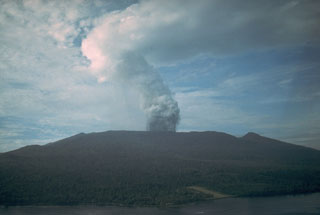Report on Karkar (Papua New Guinea) — September 1980
Scientific Event Alert Network Bulletin, vol. 5, no. 9 (September 1980)
Managing Editor: David Squires.
Karkar (Papua New Guinea) New fumarolic vents; seismicity intensifies
Please cite this report as:
Global Volcanism Program, 1980. Report on Karkar (Papua New Guinea) (Squires, D., ed.). Scientific Event Alert Network Bulletin, 5:9. Smithsonian Institution. https://doi.org/10.5479/si.GVP.SEAN198009-251030
Karkar
Papua New Guinea
4.647°S, 145.976°E; summit elev. 1839 m
All times are local (unless otherwise noted)
"Local observers made four inspections of the summit area 8-13 September. They observed small ejections of crater floor material and water from scattered sources in the previously inactive W pool of water at the base of 1979 crater. Small dark ejections continued from the central pool, but a new gas vent was present on the crater floor nearby. The water in the pools was reported to be yellow on 13 September. Vapours rising from 1979 crater were white, and small to moderate in volume. Seismic activity intensified during September. Single volcanic earthquakes became more numerous early in the month and the tremor level showed a general strengthening at mid-month."
Geological Summary. Karkar is a 19 x 25 km forest-covered island that is truncated by two nested summit calderas. The 5.5 km outer caldera was formed during one or more eruptions, the last of which occurred 9,000 years ago. The steep-walled 300-m-deep, 3.2 km diameter, inner caldera was formed sometime between 1,500 and 800 years ago. Cones are present on the N and S flanks of this basaltic-to-andesitic volcano; a linear array of small cones extends from the northern rim of the outer caldera nearly to the coast. Recorded eruptions date back to 1643 from Bagiai, a pyroclastic cone constructed within the inner caldera, the floor of which is covered by young, mostly unvegetated andesitic lava flows.
Information Contacts: C. McKee, RVO.

